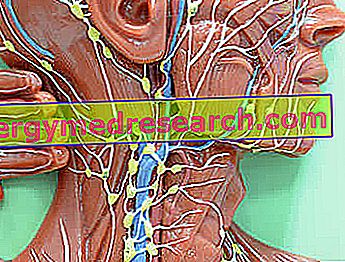Generality
Progressive ossifying fibrodysplasia ( FOP ) is a genetic disease that, in its carriers, induces the formation of lumps of bone outside the skeleton, in particular on joints and muscles.

Due to the mutation of the ACVR1 gene (a gene that controls the development and repair of bones), progressive ossifying fibrodysplasia can be a condition that human beings develop during embryonic development (which is more common) or that they inherit from one of their parents (rare).
FOP impairs the function of the joints and affected muscles, which leads, over time, to problems with walking and balance, breathing difficulties, chewing and talking, etc.
Currently, unfortunately, those suffering from progressive ossifying fibrodysplasia can only rely on symptomatic treatments - that is, aimed at alleviating the symptoms - as there is no cure able to cancel the mutation against ACVR1.
What is Progressive Oxygenating Fibrodysplasia?
Progressive ossifying fibrodysplasia is a genetic disease, in the presence of which the skeletal muscles and the connective tissue constituting the tendons and ligaments of the joints tend, spontaneously or after occasional damage, to ossify, or to change their original cells into cells typical of the tissue bone.
Progressive ossifying fibrodysplasia is a congenital condition, where congenital means that its carriers are affected from birth (although the consequences are not evident from this moment).
Progressive ossifying fibrodysplasia is also known by the acronym FOP, whose component letters are a clear reference to the three terms used to define the conditions object of this article.
Did you know that ...
Progressive ossifying fibrodysplasia is included in the list of connective tissue diseases, such as Ehlers-Danlos syndrome or Marfan syndrome.
Epidemiology
Progressive ossifying fibrodysplasia is a rare disease; according to statistics, in fact, worldwide, an individual would be affected about every 2 million.
According to an epidemiological data of 2017, all over the world, patients with progressive ossifying fibrodysplasia would be around 800.
Causes
Progressive ossifying fibrodysplasia is due to a specific mutation of the ACVR1 gene, located on chromosome 2 .
In most cases, the aforementioned mutation is the result of a spontaneous event, which occurs without a precise reason, during the course of embryonic development (ie after the spermatozoon fertilized the egg and embryogenesis began); more rarely, the ACVR1 mutation responsible for FOP is the result of parental transmission, ie the patient receives it from one of the parents.
The first kind of ACVR1 mutation is an example of acquired mutation and the resulting condition is called acquired-type progressive ossifying fibrodysplasia ; the second kind of ACVR1 mutation, on the other hand, is an example of a hereditary mutation and the consequent condition is called hereditary progressive ossifying fibrodysplasia .

What are the consequences of the ACVR1 Mutation?
Premise: the genes present on human chromosomes are DNA sequences that have the task of producing fundamental proteins in biologic processes indispensable to life, including cell growth and replication.
The ACVR1 gene produces a receptor protein capable of regulating the growth, development and repair, where necessary, of the skeletal system.
In healthy people, the ACVR1 gene is activated as needed, which guarantees a fine control of the processes of growth, development and repair of skeletal bones.
For example, the unmutated ACVR1 gene is one of the people responsible for the ossification process, which characterizes the skeletal maturation of the human being, in his transition from a young age to adulthood.
In people with progressive ossifying fibrodisplasia, on the other hand, the ACVR1 gene is, due to its mutation, always active ( constitutive activation ), which involves the loss of fine control of the processes indicated above and the occurrence of a phenomenon such as formation of bone tissue instead of connective tissue (for example, instead of cartilage, tendons, etc.) and instead of muscles.
Progressive Oxygenating Fibrodysplasia is an Autosomal Dominant Disease
To understand...
Each human gene is present in two copies, called alleles, one of maternal origin and one of paternal origin.
Progressive ossifying fibrodysplasia has all the characteristics of an autosomal dominant disease .
A genetic disease is autosomal dominant when the mutation of only one copy of the gene that causes it is sufficient to manifest itself.
Symptoms and Complications
Progressive ossifying fibrodysplasia causes the formation of lumps of bone outside the skeleton, mainly on the tendons and ligaments of the joints, and on the muscles. Furthermore, in the event of a fracture, it is responsible for an over-growth of the affected bone, while, in the case of muscle injuries, it determines the replacement of the muscular tissue involved with tissue of bone nature.
As a result of all this, progressive ossifying fibrodysplasia results in a loss of mobility on the part of the muscles and joints involved, with logical repercussions on the patient's motor skills.
Did you know that ...
The lumps of bone tissue that the FOP causes outside the skeleton are called ectopic ossification foci .
The effects of Progressive Oxygenating Fibrodysplasia: the details
As a rule, progressive ossifying fibrodysplasia attacks the human body from the top ; therefore, at first, it affects the muscles and joints of the compartments such as the head, neck, dorsal region, thorax, shoulders and upper limbs, and, subsequently, compromises the muscular and articular functionality of the abdomen, pelvis, lumbar region and limbs lower.
In terms of symptoms, progressive ossifying fibrodysplasia is known to cause:
- Signs of inflammation ( edema in particular) in those anatomical departments affected by the growth of extra bone tissue.
- Difficulty in chewing and speaking . They are a consequence of when the disease in question attacks the temporomandibular joint, whose correct functioning is fundamental for chewing and phonation.
Difficulties in chewing are responsible for malnutrition.

- Difficulty expanding the rib cage and consequent breathing problems . They are observed in the moment in which the FOP affects, through the formation of extra bone, the muscles and the joints of the chest.
- Difficulty in moving the upper and lower limbs, and consequent problems of balance and coordination . They are a consequence of when FOP ossifies important joints such as the shoulder, the elbow or the knee.
The problems of balance and coordination are often the cause of accidental falls, which can further worsen the patient's state of health; in fact, any muscle or joint fractures or injuries that may result from an accidental fall are followed by unusual repair processes, which lead to the formation of extra bone tissue.
- Spinal deformations . They are the result of when the disease affects the joints between the various vertebrae and the back muscles.
It is important to note that, in addition to the aforementioned consequences, progressive ossifying fibrodysplasia is also associated with some congenital malformations, including the presence of deformed toes (this is a sign that characterizes practically all cases of FOP) and the presence of short thumbs (it is common, but not as deformed toes).
Did you know that ...
Progressive ossifying fibrodysplasia spares some parts of the human body. For example, it does not cause the formation of unwanted bone on: tongue, myocardium, smooth muscle, extraocular muscles and diaphragm.
Onset of Progressive Oxygenating Fibrodysplasia: when does it occur?
Generally, progressive ossifying fibrodysplasia begins to show the first signs of its presence during early childhood ; surely, under the tenth year of life of the patient, he has already given full demonstration of himself.
Complications
Over the years, the presence of extra bone in FOP patients becomes more and more considerable. This leads to the development of various complications, including:
- Severe breathing problems;
- Immobility;
- Inability to feed followed by a serious state of malnutrition;
- Inability to speak.
Diagnosis
To formulate the diagnosis of progressive ossifying fibrodysplasia, an accurate physical examination, a scrupulous medical history and a genetic test are indispensable.
Progressive ossifying fibrodysplasia is a condition whose identification occurs, in a good percentage of cases, later than is due. This depends, fundamentally, on the rarity of FOP: before thinking of the latter, in fact, doctors think of more common diseases that cause similar symptoms (eg: bone tumors, fibrous dysplasia, aggressive juvenile fibromatosis, etc.).
Anamnesis and physical examination
Anamnesis and physical examination consist essentially in an accurate evaluation of the symptomatology exhibited by the patient.
In a context of progressive ossifying fibrodysplasia, it is in these phases of the diagnostic procedure that the doctor verifies the presence of some typical consequences of the disease in question, such as:
- The deformed big toes;
- The difficulties of movement;
- The problems of balance and poor coordination;
- The tendency to accidental falls;

- The sudden appearance on the body of signs of inflammation.
Genetic test
It is the DNA analysis aimed at detecting mutations of critical genes.
In a context of progressive ossifying fibrodysplasia, it represents the diagnostic test of confirmation, as it allows to highlight the ACVR1 mutation.
Therapy
The possibilities of treatment of progressive ossifying fibrodysplasia are exclusively symptomatic - that is aimed at alleviating the symptomatology and postponing complications - as there are no treatments, at least for the moment, capable of canceling the mutation, either before birth or at birth. responsible for the disease in question and its consequences.
Symptomatic therapy: what does it consist of?
The list of possible symptomatic treatments that can be adopted against progressive ossifying fibrodisplasia includes:
- The administration of NSAIDs or corticosteroids, in order to counteract the sudden inflammatory episodes;
- The use of braces and other walking aids, in order to avoid accidental falls;
- Occupational therapy, in order to make everyday life less disturbing, the present genetic condition and its consequences.
Why is surgery not one of the possible treatments?
The presence of FOP strictly excludes the use of surgery aimed at eliminating the lumps of extra bone tissue. This is explained by the fact that, to any bone incision, the skeleton of the progressive ossifying fibrodysplasia patient would respond in the same abnormal way as when it undergoes a fracture, ie with an over-growth of the affected bone.
Did you know that ...
Performing a bone biopsy (ie collecting bone for a laboratory analysis) in a progressive ossifying fibrodysplasia patient is very dangerous, because it has the same effects as a fracture (or, absurdly, an eventual intervention surgery aimed at eliminating extra bone tissue).
Activities that a FOP patient should avoid?
A patient with progressive ossifying fibrodysplasia should avoid:
- Intramuscular injections, such as those for vaccination;
- The practice of sports activities;
- Excessively invasive dental procedures;
- Invasive surgical procedures.
Prognosis
Progressive ossifying fibrodysplasia is a disease with a poor prognosis, because:
- It is destined to a continuous deterioration and without the possibility of recovery;
- Causes permanent disability, which profoundly affect the quality of life;
- It is generally the cause of death around the age of 40.
Prevention
Progressive ossifying fibrodysplasia is an impossible condition to prevent .



